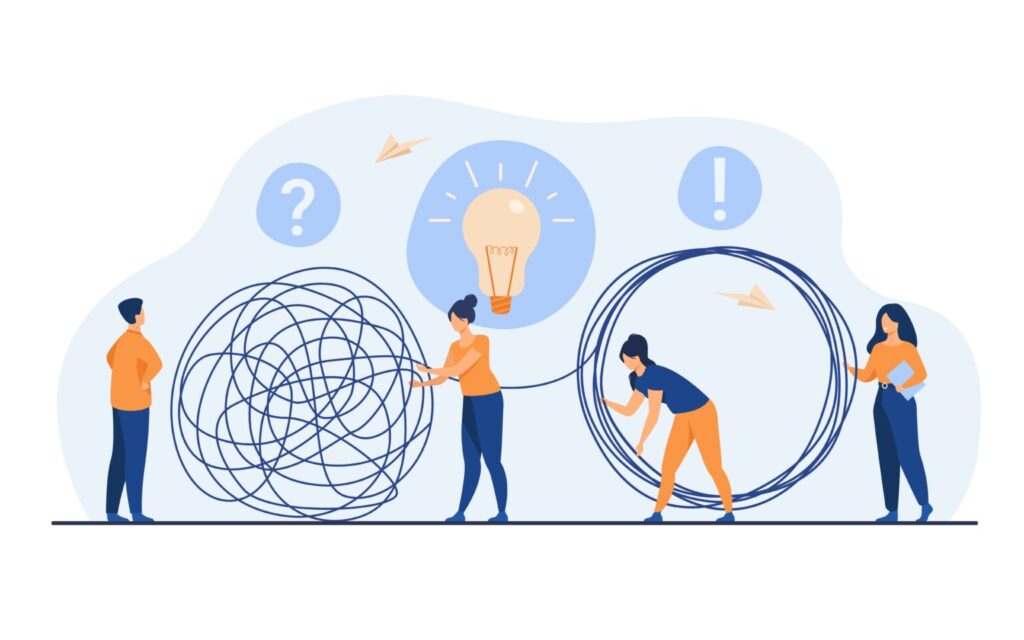Ever tried riding a unicycle while juggling burning torches? Though odd, for a project manager, that could be any Tuesday! 🤷♂️
Project management, in simple terms, means organizing anarchy. Whether constructing a new building or introducing a new app, a project manager’s strategic dance turns ideas into profitable results. PM is, in fact, the engine behind the development, not only Gantt charts and deadlines.
How significant is project management? Let’s talk numbers now. You’ll be surprised that poor management accounts for 70% of project failures1. It’s like launching a rocket without a navigation system is exciting until it crashes into the ocean. 🌕
In this blog, you will learn the fundamentals of project management. Also, the real-world case studies tell you how PM is like a superhero cape that transforms chaos into success, whether you’re starting a new business or launching the next Apollo! 🚀
Cost Management
Efficient cost management guarantees that your project stays within budget and adds value. The success of any project depends on the project manager’s ability to budget, estimate costs, and manage expenses.
Budgeting
- Make a thorough project budget that lists every cost you anticipate incurring.
- Add subcategories, including equipment, materials, labor, and emergency funds.
- For precise estimations, use industry standards and recorded data.
Cost Estimating
Estimate the necessary financial resources for every project activity by applying methods such as:
- Comparable Estimation is predicated on similar-sized projects completed previously
- Parametric Estimation uses statistical relationships between historical data and other variables
- Bottom-up Estimation calculates the total budget by adding up the expenses of the separate jobs
Controlling Costs
- Establish a reliable system for reporting and monitoring.
- Monitor actual spending to the budget, note differences, and, if necessary, take remedial action.
- Use techniques like Earned Value Management (EVM) to evaluate the success of your projects and project future expenses.
- Maintaining financial control requires routinely assessing and modifying the budget in response to project development.
Effect of Prudent Cost Control
- Prosci reports2 that projects with effective change management practices are almost 1.5 times more likely to stay on or under budget than those with inadequate change management practices.
- Efficient cost control increases the possibility of project success, improves the company’s general performance, and pleases stakeholders.
Real-World Case Study of Cost Management
The Panama Canal Expansion3, completed in 2016, is an outstanding example of strict cost control measures and innovative financial planning.
Initially estimated at $5.25 billion, the project encountered various financial obstacles. Nevertheless, it was completed with a cost overrun of nearly 9%, which is relatively low for a project of this massive scale.
The expansion has substantially increased the canal’s capacity, enabling it to accommodate vessels that carry up to 14,000 TEUs (Twenty-foot Equivalent Units), a significant increase from the previous limit of 5,000 TEUs. This advancement is anticipated to expand global trade and provide Panama with substantial economic benefits.
Risk Management

Risk Management is essential for ensuring project success to proactively identify, analyze, plan responses to, and monitor risks. The following are the primary procedures that are necessary:
Risk Identification
Process of Risk Identification
- Engage in brainstorming sessions with project stakeholders.
- Employ methodologies such as SWOT analysis (Strengths, Weaknesses, Opportunities, Threats) to identify potential risks.
- Establish a risk register to record the characteristics of all identified risks.
Risk Assessment
Qualitative Risk Assessment
- Utilize risk matrices to prioritize risks according to their probability and impact.
- Focus on the most critical risks by categorizing them as high, medium, or low priority.
Quantitative Risk Analysis
- Quantify risk impacts using statistical techniques such as Monte Carlo simulations and decision tree analysis.
- Determine the potential financial and timeline consequences of the identified risks.
Planning Risk Response
- Risk mitigation: Modify project plans to mitigate the risk.
- Mitigation: Take measures to decrease the probability or severity of the risk.
- Acceptance: Recognize the risk and be prepared to minimize its effects if it arises.
- Transfer: Transfer the risk to a third party, such as through outsourcing or insurance.
Risk Monitoring and Management
- Monitor identified risks and identify new ones continuously throughout the project’s lifecycle.
- Be sure to update the risk register with any new information or changes in risk status.
- Conduct routine risk assessments and modify risk response strategies as required.
- To guarantee the efficacy of risk management practices, implement instruments such as status meetings and risk audits.
The Influence of Effective Risk Management
- Organizations that demonstrate exceptional risk management practices achieve their project objectives 76% of the time4, as opposed to 45% for those implementing inadequate risk management strategies.
- Prosci emphasizes the significance of effective risk management in achieving project success, as it can reduce project failures by 30%5.
Real-World Case Study of Risk Management
NASA’s Mars Rover6 missions are the best examples of risk management. The uncertainties of space exploration led to the development of comprehensive risk identification and mitigation strategies for these missions. For instance, the Curiosity rover arrived on Mars in 2012 at a total mission cost of $2.5 billion.
The mission accomplished all of its primary scientific objectives, thereby substantially contributing to our comprehension of Mars despite the high stakes.
This legacy is furthered by the recent Perseverance mission, which successfully landed on Mars in 2021 and commenced its mission to seek evidence of ancient life. Thanks to risk management strategies, these missions have made groundbreaking scientific discoveries with high precision and reliability.
Task Management

Effective task management is critical for completing projects on time and within scope. Project managers can increase team productivity and project success by implementing best practices for task assignment, scheduling, and progress tracking. Here are a few key strategies:
Best Practices in Task Assignment
- Define clear tasks: Break down projects into smaller, more manageable tasks with clear goals. Make sure each task is specific, measurable, achievable, relevant, and time-bound (SMART).
- Assign responsibilities: Match tasks to team members’ skills and expertise. Clarify roles and responsibilities to avoid confusion and ensure accountability.
- Set Priorities: Prioritize tasks according to their importance and urgency. Use techniques such as the Eisenhower Matrix to distinguish between important and urgent tasks.
Scheduling
- Create a detailed schedule: Include tasks, deadlines, and milestones. Gantt charts, for example, can help you create a visual timeline of project activities.
- Allocate resources: Ensure all required resources, such as personnel, equipment, and budget, are available for each task. Proper resource allocation avoids bottlenecks and delays.
- Set realistic deadlines: Based on the team’s capacity and workload, set realistic deadlines for each task. Avoid overcommitting to unrealistic timelines, which can result in burnout and missed deadlines.
Progress Tracking
- Use Project Management Tools: Use Mirorim to track task progress and keep everyone informed. These tools enable real-time updates and communication among team members.
- Regular check-ins: Schedule regular meetings to review progress, address issues, and adjust plans as needed. Daily stand-ups or weekly status meetings can help to keep momentum and the project on track.
- Monitor Key Metrics: Monitor key performance indicators (KPIs) like task completion rates, time spent on tasks, and resource utilization. Use these metrics to identify areas for improvement to make sure project objectives are met.
The Impact and Real-World Case Study
- Prosci’s report7 found that teams that use task management tools are 20% more likely to complete projects on time and within budget.
- Apple’s development of the iPhone 8 exemplifies effective task administration. In 2004, the iPhone project was initiated and subsequently launched in 2007. This project necessitated the seamless incorporation of hardware, software, and user interface design and the coordination of over 200 patents.
Apple completed the project within its ambitious timeline thanks to Agile Project Management and rigorous task management practices. The product transformed the smartphone industry, selling more than 1.2 billion units by 2017. Despite the iPhone’s continued market dominance, it has established new standards for mobile technology and substantially contributed to Apple’s revenue.
▶️ Assigning tasks based on team strengths and ensuring clear responsibilities can lead to more effective task management. If you’re looking for ways to enhance your team’s overall performance and dynamics, our article on effective team dynamics provides practical strategies
Project Constraints

Managing project constraints, including scope, time, cost, quality, and resources, is critical for project success. You can overcome challenges and successfully complete projects by effectively managing these elements.
Scope
- Define the project scope: Begin with a detailed project scope statement outlining the project’s objectives, deliverables, boundaries, and constraints. A clear scope definition prevents scope creep and maintains project focus.
- Scope Control: Regularly review and validate the project scope with stakeholders. Manage scope changes using control processes, documenting and approving all changes.
Time
- Create schedules: Use project schedules using tools like Gantt charts. It must include all tasks, durations, dependencies, and milestones.
- Establish realistic deadlines: Create timelines based on team size and project complexity. Avoid overly ambitious deadlines, which lead to burnout and poor quality.
- Monitor progress regularly: Monitor progress against the schedule and adjust as needed. Use Mirorim to receive real-time updates and track task completion.
Cost
- Create a detailed budget: Include all expected expenses, such as labor, materials, equipment, and contingency funds.
- Control Expenses: Set up a reliable financial tracking system to compare expenses to budget. Review financial reports regularly and take corrective action if expenses exceed projections.
- Estimate future costs: Use tools like Earned Value Management (EVM) to forecast future costs based on current performance. That aids in developing budget overruns and making decisions.
Quality
- Define quality standards: Establish specific quality criteria and standards for project deliverables. All stakeholders should agree on these standards, which should be incorporated into the project’s quality plan.
- Perform quality assurance: Conduct regular quality assurance to ensure processes are correctly performed. That means audits, reviews, and process improvements.
- Implement quality control: Use quality control techniques to inspect and verify that project deliverables meet the required quality standards. Address any deviations immediately.
Resources
- Plan Resource Allocation: Define all required resources, including human resources, tools, and materials. Develop a strategy to outline how these resources will be acquired, allocated, and utilized.
- Optimize Resource Utilization: Ensure that resources are used effectively to avoid bottlenecks. Monitor usage regularly and adjust allocations as necessary.
- Manage resource conflicts: Prioritize tasks and negotiate with stakeholders. Effective resource management ensures that critical tasks are adequately supported.
Impact of Effective Constraint Management
- A PMI study9 discovered that projects with effective constraint management are 28% more likely to be completed on time and within budget.
- According to KPMG research10, effective constraint management can increase project success rates by up to 50%, emphasizing its role as one of the fundamentals of project management.
Read More: Power of Forecasting Methodology In Project Management for +38% Success
Communication Management

Effective communication is the backbone of any successful project. By planning how information is shared, keeping stakeholders in the loop, and managing communication thoughtfully, you can ensure everyone stays aligned and informed throughout the project. Regular check-ins, like touchpoint meetings, play a key role in keeping the team on the same page and tackling challenges
Communication planning
- Create a Communication Plan: Begin by developing a detailed communication plan that specifies how and when to share the information. This plan should cover communication objectives, key messages, target audiences, communication methods, and frequency.
- Define the roles and responsibilities: Clarify who is responsible for communicating what information. That will avoid confusion and ensure that the correct messages reach people at the appropriate time.
- Use a Communication Matrix: A communication matrix can help you visualize and track communication activities. It defines communication channels, stakeholders, and the frequency of interactions.
Information distribution
- Choose the Right Channels: To distribute information, use a variety of communication channels such as emails, meetings, reports, and collaboration tools. Tailor the channels to the preferences and needs of various stakeholders.
- Ensure Timely Updates: Regularly inform stakeholders about project progress, changes, and upcoming tasks. Timely information dissemination helps to keep everyone on the same page and reduces misunderstandings.
Stakeholder management
- Identify Stakeholders: First, list all project stakeholders, including team members, clients, sponsors, and other interested parties. Understanding your stakeholders is the first step towards effectively managing their expectations.
- Engage Stakeholders: Involve stakeholders from the start and communicate regularly. This will contribute to developing trust and ensure that their needs and concerns are met.
- Clear and concise reports: When communicating with stakeholders, ensure your messages are clear and straightforward. Avoid technical jargon and instead deliver information that is relevant to them.
▶️Engage stakeholders and respond to their needs and expectations. Tools like relationship mapping software can help you visualize and strengthen these connections, ensuring better support and collaboration from stakeholders.
Implications of Effective Communication Management
- Effective communication practices are 80% more likely to finish projects on time and within budget, as the PMI reported11.
- Poor communication is responsible for 33% of project failures12. This highlights the importance of effective communication as one of the essential fundamentals of project management.
Real-World Case Study of Communication Management
Through sophisticated ICT and social media marketing strategies, the London 2012 Olympics 13 effectively managed communication. This included a Twitter-driven light show on the London Eye that reflected the daily sentiment of the public.
A dedicated Technology Operations Centre (TOC)14 coordinated data across 94 venues and oversaw the operation of 900 servers, 1,000 network devices, and 9,500 computers to provide the seamless exchange of real-time information.
Athletes were trained extensively to publish consistent and engaging messages. Crisis management procedures were implemented to address unexpected issues, such as the North Korean flag mix-up and empty seats, by issuing immediate apologies and reallocating tickets.
Implementing preemptive warnings to manage public expectations regarding transport congestion resulted in better-than-expected experiences, which helped preserve trust and prevent chaos.
Change Management

Change management means handling change requests, running impact assessments, and supervising the change control process. Learning this skill gives you seamless transitions and project integrity.
Processing change requests
- Establish a clear process: Develop a structured approach to submitting and reviewing change requests. Use forms and templates to record all necessary information.
- Evaluate requests promptly: Evaluate change requests as soon as they arrive. Prioritize them according to urgency and potential impact.
- Involve stakeholders: Engage stakeholders in the evaluation process. Their feedback is critical for understanding the importance of the proposed changes and ensuring that they agree with project goals.
Impact analysis
- Examine Potential Impacts: Determine how a change will affect your project’s scope, schedule, cost, quality, and resources. Use tools like impact assessment matrices to assess these factors thoroughly.
- Risk Assessment: Identify potential risks associated with the change and create mitigation strategies to ensure proper preparation.
- Documentation: Create a change log to track the impact analysis results. This documentation ensures transparency and serves as a reference for future decisions.
Change Control
- Establish a Change Control Board (CCB): This board should have key stakeholders who will approve or reject change requests. It should hold regular meetings to review and discuss proposed changes.
- Apply the Approved Changes: Once approved, revise project plans, schedules, and budgets accordingly. Make sure your team understands the changes and their respective responsibilities.
- Monitor and review: Continuously monitor the implementation of changes to ensure that they are carried out as intended. Conduct regular reviews to assess the effectiveness of the changes and make adjustments as necessary.
Implications of Effective Change Management.
- According to Prosci15, projects with effective change management practices are nearly 1.5 times more likely to stay on budget.
- Projects with strong change management are 6 times more likely to achieve their objectives16 than those with poor change management practices.
Real-World Case Study of Change Management
Royal Bank of Scotland (RBS)17 experienced substantial obstacles due to data inconsistency, inefficient manual processes, and fragmented governance in 20 business areas, each utilizing distinct Project Portfolio Management (PPM) tools.
RBS enhanced transparency and control over its project portfolio by integrating data into a single PPM solution and implementing Lean-Agile practices. This transition necessitated the transition from conventional project management to incremental, iterative value delivery and the integration of leaders into Agile planning processes. That guaranteed accountability and real-time decision-making processes.
This way, RBS significantly improved efficiency and cost by decommissioning 35 legacy systems, reducing the approval process for business cases from 8 weeks to less than 12 days, and reducing the number of annual business cases from 400 to 25. Notably, that happened despite cultural resistance and initial misunderstandings due to limited Agile proficiency.
This transformation facilitated the implementation of more effective financial and resource management decisions, transitioning RBS from a 90% traditional approach to a combination of 70% traditional and 30% Agile methodologies.
Read More: 10 Proven Hacks for Reducing the Duration of Project Management
Essential Tools and Techniques
| Tool/Technique | Overview | Practical Use | Benefits |
| Gantt Charts | Visual timeline for project tasks showing start and end dates, dependencies, and progress. | Use software like Microsoft Project or online tools such as Smartsheet or Trello. Input tasks, set dependencies, and assign start/end dates. Update regularly and use in team meetings. | It helps in planning and scheduling, enables efficient resource allocation, provides a clear visual representation of the project timeline, and facilitates better communication. |
| Critical Path Method (CPM) | The step-by-step technique identifies the longest sequence of tasks that must be completed on time for the project to finish on schedule. | Map out all project tasks, including durations and dependencies. Calculate the earliest/latest start and finish times to identify the critical path. Focus on managing tasks on the critical path. | Prioritizes work to ensure key deadlines are met, reduces the risk of project delays, and helps in resource allocation by identifying tasks that can be delayed without affecting the project. |
| PERT Charts | A technique used to estimate project duration by analyzing the time required to complete each task and its dependencies. | Create a PERT chart by listing all project tasks and estimating the shortest, longest, and most likely timeframes. Calculate the expected time for each task to determine the overall project duration. | Aids in better planning and risk management by identifying optimistic, pessimistic, and realistic time estimates for tasks. |
| Work Breakdown Structure (WBS) | Hierarchical decomposition of the total scope of work to accomplish project objectives and create deliverables. | Develop a WBS by dividing the project into major deliverables and subdividing it into smaller tasks. Use a tree structure or outline format. Assign responsibilities and track progress. | Organizes and defines the total work scope of the project, makes it easier to assign responsibilities, track progress, and manage project scope effectively. |
| Resource Allocation Tools | Tools for planning, scheduling, and managing resources across multiple projects to ensure efficient use and minimize conflicts. | Use tools like Microsoft Project, Resource Guru, or TeamGantt to plan and allocate resources. Input resource availability, assign resources to tasks, and monitor utilization. Adjust as needed. | Provides visibility into resource availability, workload, and utilization. Enhances coordination and ensures resources are available when needed, contributing to smoother execution. |
Impact of Using Project Management Tools
- Improved Project Performance: Project management tools improve performance by 30%18, enhancing efficiency and ensuring projects are completed on time and within budget.
- Higher Project Success Rates: 77% of high-performing organizations 19use project management software to improve collaboration and streamline processes, leading to higher project success rates.
Conclusion
Key Takeaways
- Cost management: Budgeting, estimating costs, and controlling expenses are critical to project success.
- Risk management: Identify and plan for risks to keep your project stable.
- Task management: Assign, schedule, and track tasks to ensure smooth execution.
- Communication management: Clear strategies for communication and stakeholder engagement are essential.
- Tools and techniques: Use Gantt charts, CPM, PERT charts, and WBS to streamline planning and resource allocation.
- Project life cycle: Understanding project phases and processes is key to achieving your goals.
- Core components: Know your charters, plans, scopes, schedules, budgets, and teams inside and out.
Mastering these basics is your first step to managing successful projects. Want to take things further? If you’re working with creative teams, check out our complete guide for Creative Project Manager to learn how to balance innovation with results.
FAQs | Project Management Fundamentals
Initiation: Defining the project at a broad level.
Planning: Establishing a roadmap for everyone to follow.
Execution: Implementing the plan and managing the work.
Monitoring and Controlling: Tracking the project’s performance and making adjustments.
Closure: Finalizing all project activities.
Clarity: Clear understanding of goals and objectives.
Consistency: Uniform procedures and methods.
Communication: Effective information exchange.
Collaboration: Teamwork and stakeholder engagement.
Commitment: Dedication to project goals.
Competency: Skilled team members.
Creativity: Innovative solutions and problem-solving.
Leadership: Guiding and motivating the team.
Communication: Ensuring clear and compelling exchange of information.
Time Management: Prioritizing tasks and managing time efficiently.
Risk Management: Identifying, analyzing, and mitigating risks.
Stakeholder Management: Engaging and managing stakeholder expectations.
Initiation: Defining the project and its feasibility.
Planning: Detailing the roadmap and resources required.
Execution: Carrying out the project plan.
Monitoring and Controlling: Tracking progress and performance.
Closure: Completing and closing all project work.
Planning: Setting goals and defining the roadmap.
Organizing: Allocating resources and assigning tasks.
Leading: Directing and motivating the team.
Controlling: Monitoring progress and making necessary adjustments.
Defining clear goals and objectives.
Creating a detailed project plan.
Assigning tasks and resources.
Monitoring progress and performance.
Ensuring effective communication.
Leadership: The ability to inspire and guide the team.
Communication: Ensuring clear and concise information flow.
Problem-Solving: Addressing issues promptly and effectively.
Time Management: Prioritizing tasks and meeting deadlines.
Risk Management: Identifying and mitigating potential issues.
Communication: Facilitating clear and effective interactions.
Initiation: Starting the project.
Planning: Developing a roadmap.
Execution: Implementing the plan.
Monitoring and Controlling: Tracking progress.
Closure: Completing the project.
Sort: Eliminate unnecessary elements.
Set in Order: Organize items for easy access.
Shine: Clean the workspace.
Standardize: Establish consistent procedures.
Sustain: Maintain and review processes regularly.
Initiation: Defining the project.
Planning: Outlining the roadmap.
Execution: Carrying out the plan.
Monitoring and Controlling: Tracking and adjusting.
Closure: Finalizing the project.
Planning: Creating detailed project plans.
Organizing: Allocating resources and tasks.
Leading: Directing and motivating the team.
Controlling: Monitoring progress and making adjustments.
Planning: Setting goals and defining strategies.
Organizing: Arranging resources and tasks.
Leading: Guiding and motivating the team.
Controlling: Monitoring performance and making corrections.
Leadership Skills: Inspiring and guiding the team.
Effective Communication: Ensuring clear information flow.
Problem-Solving Abilities: Addressing and resolving issues promptly.
Applying knowledge, skills, tools, and techniques to project activities to meet the project requirements.
A structured approach to planning, executing, and finalizing projects.
What: Defining the project scope and objectives.
Why: Understanding the purpose and benefits.
Who: Identifying stakeholders and team members.
When: Establishing timelines and deadlines.
Plan: Detailed roadmap.
Process: Established procedures.
People: Skilled team members.
Power: Decision-making authority.
Performance: Monitoring and assessment.
Sort: Remove unnecessary items.
Set in Order: Organize for efficiency.
Shine: Clean and maintain the workspace.
Standardize: Create uniform procedures.
Sustain: Continuously improve processes.
References
- Zarrella, E., Tims, M., Carr, B., & Palk, W. (2005). Global IT Project Management Survey. https://assets.kpmg.com/content/dam/kpmg/pdf/2009/12/Global-IT-Project-Management-Survey-0508.pdf ↩︎
- Taylor, S. (2023, May 23). Make the Case: Connect Change Management to Project Results. https://www.prosci.com/blog/the-ultimate-case-maker-connecting-change-management-and-project-results ↩︎
- Jeong, H., Crittenden, J. C., & Xu, M. (2008). Panama Canal Case Study. In HowStuffWorks.com. https://research.gatech.edu/sites/default/files/inline-files/panamnacanalcasestudy_hyunju.pdf ↩︎
- Fraser, J. R. S., Simkins, B. J., Narvaez, K., & Hoboken, New Jersey : Wiley. (n.d.). Implementing enterprise risk management : case studies and best practices in SearchWorks catalog. Standford University. Retrieved August 13, 2024, from https://searchworks.stanford.edu/view/13206175 ↩︎
- Finesta Financial Case Study – Part 1. (2021). Prosci. Retrieved August 13, 2024, from https://prosci.com/hubfs/2.downloads/training-forms/2021-Practitioner-Prework/Task5-FinestaCaseStudy-Practitioner-Fillable-v02.pdf?hsLang=en-us ↩︎
- Shishko, R., & Matijevic, J. R. (1997). Summary of Results from the Risk Management Program for the Mars Microrover Flight Experiment. In Abstract (https://ntrs.nasa.gov/api/citations/20000057279/downloads/20000057279.pdf). ↩︎
- Finesta Financial Case Study – Part 1. (2021). Prosci. Retrieved August 13, 2024, from https://prosci.com/hubfs/2.downloads/training-forms/2021-Practitioner-Prework/Task5-FinestaCaseStudy-Practitioner-Fillable-v02.pdf?hsLang=en-us ↩︎
- UKEssays. (November 2018). Development of the Apple iPhone. Retrieved from https://www.ukessays.com/essays/technology/development-of-the-apple-iphone-4190.php?vref=1 ↩︎
- Langley, M. (2017). Transforming the high cost of low performance. In 9th Global Project Management Survey. Retrieved August 12, 2024, from https://www.pmi.org/-/media/pmi/documents/public/pdf/learning/thought-leadership/pulse/pulse-of-the-profession-2017.pdf ↩︎
- 2021 AIPM AND KPMG Project Management Survey. (2021). Australian Institute of Project Management. Retrieved August 13, 2024, from https://assets.kpmg.com/content/dam/kpmg/au/pdf/2021/kpmg-aipm-project-management-survey-2021.pdf ↩︎
- Rajkumar, S. (2010). Art of communication in project management. Paper presented at PMI® Research Conference: Defining the Future of Project Management, Washington, DC. Newtown Square, PA: Project Management Institute. https://www.pmi.org/learning/library/effective-communication-better-project-management-6480 ↩︎
- Arora, S. K. (2023). Project Failure: A Bad Communication (Case Study). International Journal of Management and Humanities, 9(5), 5–7. https://doi.org/10.35940/ijmh.e1553.019523 ↩︎
- Technology plays major role in London 2012. (2012, August 9). Olympics.com. https://olympics.com/en/news/technology-plays-major-role-in-london-2012 ↩︎
- Case study: Assuring London 2012 with testing by Acutest – Acutest. (2024, July 18). Acutest. https://www.acutest.com/resources/assuring-london-2012/ ↩︎
- Taylor, S. (2023, May 23). Make the Case: Connect Change Management to Project Results. https://www.prosci.com/blog/the-ultimate-case-maker-connecting-change-management-and-project-results ↩︎
- Anderson, S. (2024, July 31). The Correlation Between Change Management and Project Success. https://www.prosci.com/blog/the-correlation-between-change-management-and-project-success ↩︎
- Rassanjani, S. (2022). Brexit and Change Management: A Case Study of the Royal Bank of Scotland. Rassanjani | the International Journal of Business Review (the Jobs Review). https://doi.org/10.17509/tjr.v5i2.52062 ↩︎
- Chang, E. (2023, November 24). Case Study: Optimize Project Management for Healthcare | Consultport. Consultport. https://consultport.com/resources-library/case-study-project-management-healthcare/ ↩︎
- Insights and Trends: Current Programme and Project Management Practices. (n.d.). https://www.pwc.com/cl/es/publicaciones/assets/insighttrends.pdf ↩︎


0 Responses
Hi, tnx for the lit article! would you recommend a good youtube channel for learning the project management fundamentals?
Hello Precious 👋
Thank you so much for your interest in the article! Speaking of personal taste, I’m a big fan of Adriana Gridler‘s channel.